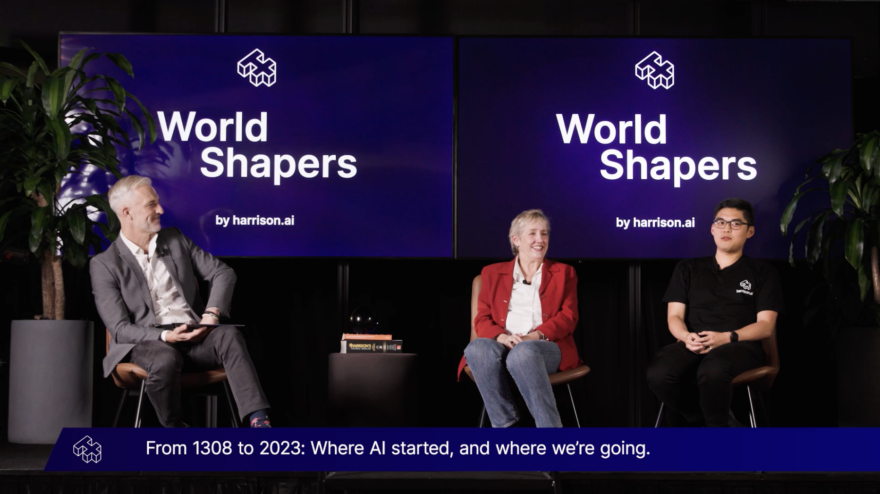In fact, AI is being used more than ever by both businesses and the general population with language model-based platforms like ChatGPT becoming mainstream. With 1 million users in December 2022, ChatGPT has grown to 1.6 billion users in June 2023, seemingly overnight.

World Shapers
As an AI-powered business, Harrison.ai is at the helm of discussions around how AI can be implemented to better the world we live in. To make these kinds of conversations freely available, we’ve created an online panel series named World Shapers, where the best minds in AI, technology & healthcare come together to debate the latest AI trends, breakthroughs and businesses.
In our first panel session, we spoke with Harrison.ai Clinical Director Jarrel Seah, Lecturer in AI at the Australian Institute of Management, Lauren Papworth and Technology Policy Researcher at UTS, Linda Przhetsky. Watch the full World Shapers online session, or check out our run down of the key takeaways on how AI has shaped the world around us and how that’s set to continue.
The rise of generative technology and its mainstream appeal
Unless you’ve been living under a rock, you’ve probably already heard about how AI is being used by the masses. By democratising our access to vast volumes of knowledge, AI helps us learn at a rapid rate.
As Laurel explains, “if social media democratised people being able to write articles and post videos, then Chat GPT democratises our access to vast volumes of knowledge.”
ChatGPT and other large language models (LLMs)
Large language models (LLMs) are enabled by AI accelerators, which are able to process vast amounts of text data, mostly scraped from the Internet. It is this technology that powers platforms like ChatGPT, however the success and accuracy of such platforms is hotly debated.
While humans have higher reasoning abilities, at present AI is battling an ongoing struggle with fluency and accuracy. That is, they may understand a problem that requires quick thinking, known as system one thinking, however when there is reasoning required or large amounts of ‘working out’ to be done, they may report inaccurate results.
Jarrel explains, “humans have two ways of thinking. System one acts very quickly, so if I say what’s 1+1, you will say 2. But if I say 65,536 divided by 72, you’ll take longer. LLMs are very good at the 1+1 = 2 type thinking but very bad at 65,536 divided by 72 because they don’t have system two thinking and the ability to work out step by step what to do.”
“Current generation of AI solves system one thinking problems, which gives humans more time to do system two thinking which is where they really add value. Once AI technologies become accurate in complex problems by engaging system two thinking, that is where you will see the biggest impact on society.”
Using human reasoning alongside AI
All panel members agreed that really exciting things happen when human reasoning and AI combine. In the case of ChatGPT, Laurel suggests that using temperature can be one way to garner more accurate results.
“There’s something called temperature with AI. Zero is factual and one is creative. Set it close to one when you want it to come up with a story or something creative. Meanwhile, you might want a temperature closer to zero if you’re writing something factual. The default setting on ChatGPT is 0.7. What I’ve got into the habit of doing now is when I’m using AI is I will set my temperature to 0, which is search, retrieve and cite. That then makes the information factual.”
This system allows people to use generative AI to recall information, saving time and teaching humans new facts very quickly.
“ChatGPT is very useful in subjects you don’t know anything about. It’s very good at summarising information and bringing me up to 80% knowledge much quicker than I could do alone”, Jarrel adds.
However, when it comes to solving a problem that a human can’t, tools like ChatGPT are exposed. Jarrel says, “I think ChatGPT is a great tool, but I’ve never used it for a problem I couldn’t solve myself.”
Where will AI take us in the future?
Each panellist had their own take home comments on where AI might take us in the future, each focused on an area that interests them most.
For Linda, it was the environmental solutions that AI has the potential to solve that bring hope. Meanwhile, Jarrel’s hope for AI is in the medical sector. He comments, “medicine features a lot of system one thinking, it’s highly specialised and very labour intensive which makes it hard to deliver across different parts of the world. AI in healthcare can deliver diagnostics that can solve the system one problems across the globe, saving time for medical professionals and predicting diagnostic results with accuracy.”
For Laurel, the prospect of huge change in terms of how humans work and live is the most exciting part of the evolution of AI. “I see people having more freedom in their 9-5. By co-piloting with AI, you will be able to get new jobs and as a society we will release people to be full human beings as opposed to just doing mundane jobs. AI has the potential to change life on a human evolutionary level”, she says.
Keen for more discussion? Watch the full session to keep up to get the full scoop. Or check out other World Shapers session, Are we at the global tipping point of healthcare?
You can also subscribe below to stay up to date with the latest news and events from the world of Harrison.ai.










